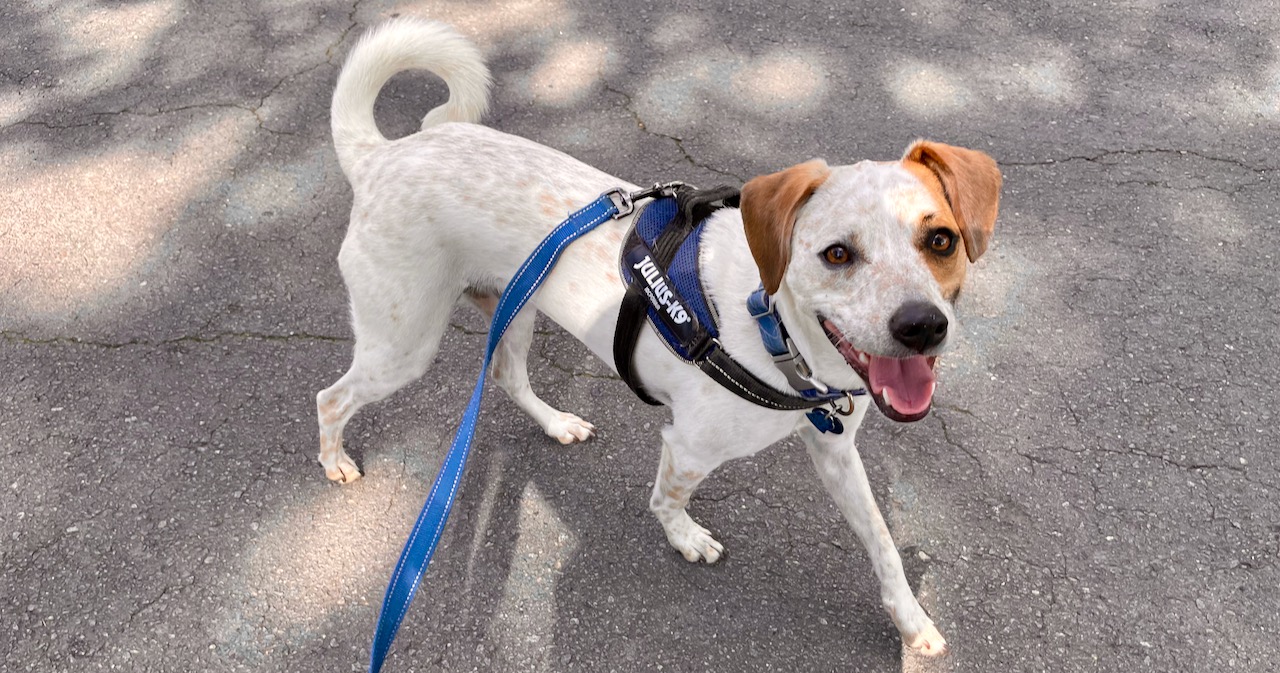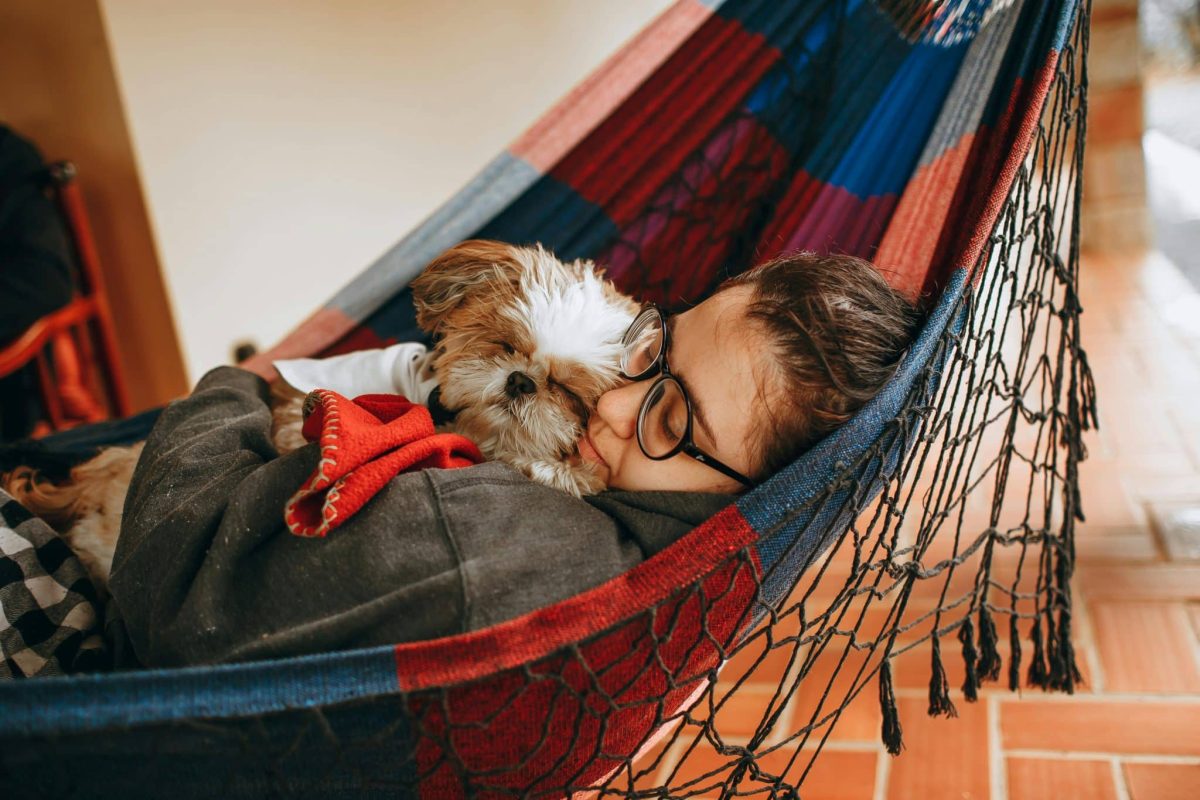I don’t do many reruns, but it seemed timely to update and republish this post from June 2022 about teaching Lewis to get into a swimming pool. I hope it gives some ideas to other people who might be acclimating their pups to a pool.
In a place with sweltering summers, a way to cool off an active dog like Lewis is a must! And it’s a bonus if he can have fun doing it. So I got a doggie swimming pool. They have improved a lot since I got one for Clara about 10 years ago. I got a moderately large one for Lewis, not thinking about the challenges that might present for him.
He was unwilling to jump into it at first, so I’m going to share the systematic way I introduced him to the pool.
There were some indicators that Lewis would eventually have a blast in it. He is an all-weather dog. He was entranced by snow last winter. He runs around without inhibition in the rain, even deliberately splashing in puddles. I guessed he’d figure out ways to enjoy the pool.
I knew he might not trust the whole endeavor right away. So for his first introduction to the pool, I made it easy, or so I thought. I chose a hot day (antecedent arrangement). I put the pool in a sunny area so the water would warm up a little and filled it only partway full. I threw a couple of his toys in there that would float. I got in there myself and beckoned him.
No go. No way in hell was he going to hop over the 12-inch wall into the pale blue unknown. What I thought might be easy was impossible for him. I learned as we went along that his caution was more about the enclosing wall than the water inside.
So, on to Plan B. I would work out a sequence of graduated exposures. The goal was for Lewis to feel happy and confident about jumping into the pool, first empty and then with water in it. I needed to create a series of desensitizing activities that weren’t scary for him. And we got there! Here’s how we did it.
Although this post is long and detailed, the total training time was about 15 minutes.
Note: this method was for introduction to a kid’s above-ground pool only. If you need to teach your dog to swim in a built-in pool, check out “How to Teach Your Dog to Swim” on the Karen Pryor Clicker Training site.
Desensitizing to Jumping into the Swimming Pool
Lewis is curious and bold but was reluctant to get into this new object in his environment, water or no. It was a little too weird, and the walls were too high for him to step over in a way he felt safe. I could have bent the wall down somewhat and started that way, with me shaping him to step into the pool space. But that could have proved awkward as we proceeded. And I wanted to address the problem at its root and teach him that if I present an object for him to interact with, it’s safe and an opportunity to have fun.
To get him to trust that it was OK to jump in and out, we worked on three foundation skills:
• getting into things
• getting onto things
• jumping over something
I split each of these into a series of behaviors. I combined desensitization with operant conditioning. The desensitization part was the very gradual exposures (you’ll see the list below). The operant conditioning part was using positive reinforcement when Lewis interacted with the objects.
If he had been afraid of these objects in themselves, I would have leaned toward a classical approach, but I didn’t need to. The pool had already been in his environment for a few days, and he had never been scared of it. Jumping in was the challenge.
I had seen him be similarly reluctant with other objects. Here is a video showing his baseline response—avoidance—when invited to jump over or get in some objects, including the swimming pool.
Rather than trying to shape him to get into one thing, as I tried with the tray in the “avoidance” video above, I gathered a series of objects with varied characteristics for him to get on, over, or in. Marge Rogers and I refer to such setups in our book about puppy socialization as “confidence courses.” I positively reinforced his interactions to extend his palette of behaviors and build happy associations with the objects and activities. I took things slowly enough that he was hardly ever reluctant to try something I set up. After getting on a couple of platforms and a flat box, he stepped right into the tray he had avoided earlier.
Desensitization Order
This is the order of the activities I used to teach him it was safe to jump into the pool. I never lured him onto or into anything with food or toys. I used a little targeting, but mostly waited for him to get the idea and get in on his own, then I reinforced generously.
• Step onto a 2″ elevated platform. (The platforms are important later.)
• Jump onto a 12″ elevated platform (a Klimb). He already knew how to do this, loved this platform, and was used to stationing there.
• Step onto a mat (also something he already knew to do).
• Step onto a piece of cardboard on the floor while I anchor it (no sliding!).
• Step into a large, shallow plastic tray (this was a big step, even with a tray with very shallow sides).
• Step into a shallow cardboard box with two flaps ripped off.
• Step into a cardboard box with all flaps intact.
• Step into other cardboard boxes.
• Jump over an agility jump set at 2″. This was another object he walked by many times every day but was reluctant to interact with when I asked him to.
• Jump onto a 12″ platform while it is next to and abutting the pool.
• Jump onto a 12″ platform while it is inside the pool (no water).
• Jump from the 12″ platform onto the 2″ platform in the pool.
• Jump down from one of these into the pool.
• Jump directly into the (dry) pool.
• Repeat a selection of the last few steps with water in the pool, and perhaps Eileen in the pool as well.
• Jump directly into the pool with water in it.
First Steps with the Platforms, Boxes, and Jump
This video shows the foundation work we did with most of the listed objects. Yes, he really got right into the plastic tray when I asked him to, even though he wouldn’t do that earlier when I tried to shape the behavior.
Applying The Activities to the Pool
After he mastered the confidence course inside, I brought all the items outside and got him into and on them again. I added the swimming pool to the mix, with no water in it.
I put the 12″ platform next to the pool and had him get on and off a bunch of times. Then I put it inside the pool, pressed right up to the edge. He jumped on with no hesitation! We practiced that, then I put the lower platform into the pool as well. Soon he had jumped onto that one and also started jumping down into the pool itself and exploring it.
I’m proud I thought of the platform. It’s hard to split out gradations of getting into an above-ground pool. You are either in it or out of it. There are no stairs. But raising the bottom changed the nature of the jump from “into the unknown” to “onto the familiar platform.”
He was now comfortable jumping into and out of the dry pool. I took a hiatus of about a week when the weather cooled off. But during that time, the pool was on my porch, empty. He jumped in there regularly for fun and to see if something interesting had blown in. And of course, I gave him a little treat or two.
Finally, on another hot day, I put the pool back into the yard with the 12″ platform inside. I put water in it, not even an inch, just enough to create some puddles on the bottom. He happily jumped onto the platform, then from there into the pool. Then he started jumping straight into the pool from outside of it. Win!
The next time, I put about 2″ of water in it. In the video, the 12″ platform was in the pool, and in the first part, I was sitting on it. Then I got out. He made a game of running around the yard and jumping into the pool.
Why Bother with All This?
I can hear some of you chortling out there. You’ve got a puppy who loves the water so much that you can’t keep him out of it. Lucky you!
Or you just picked up your young dog and plopped him into the pool and everything worked out fine. Or maybe you even tossed him in the water to learn to swim. But even if your dog likes water now, those are risky methods.
As with all uses of aversive methods, there is a risk of fallout. If your dog came out unscathed and learned to love water, you and he were lucky. That doesn’t always happen. Certainly you didn’t mean to, but you risked traumatizing your dog. And it takes significantly longer to address the fear that typically results from that than it does to go slow at the beginning.
Speaking of “slow”—my method wasn’t slow. It took much, much more time to write up this post and edit the movies than to do the training. As I mentioned above, there were fewer than 15 minutes of training, and they included the fun play at the end. Those 15 minutes gave my dog something that will enrich him for the rest of his life.
Copyright 2022 Eileen Anderson
Related Posts
• You Can’t Cure MY Fear by Shoving Cookies at Me! (this post also features a list of desensitizing, graduated exposures, but they are for something completely different)
• Teaching a Dog to Station While Another Dog Works (more platform work!)






